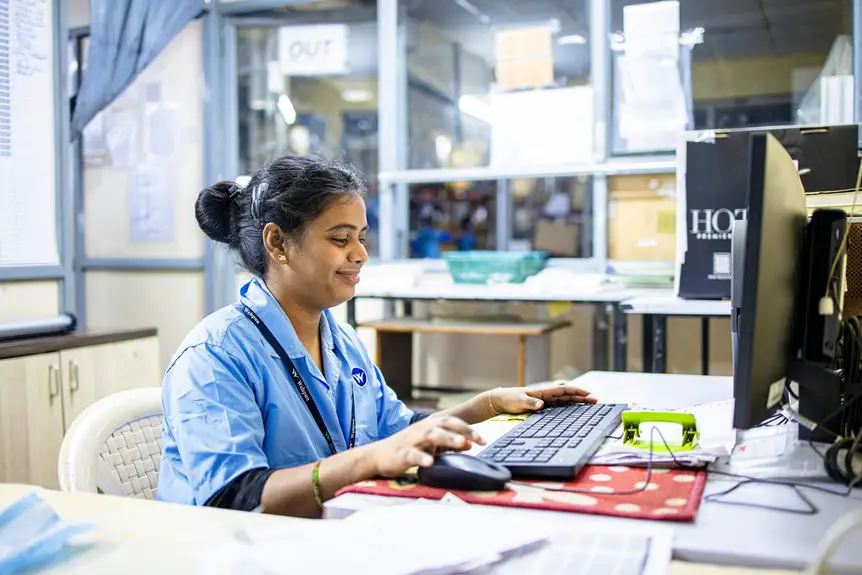Choosing the right monitor size for your work can significantly impact your productivity and comfort. It's essential to assess your specific tasks and workspace before making a decision. A larger screen might boost your multitasking capabilities, but that doesn't mean it's always the best fit for everyone. Let's explore the key factors to consider, ensuring you find the perfect balance between functionality and personal preference.
Table of Contents
Key Takeaways
- Assess your daily tasks; larger screens are ideal for graphic design, while smaller monitors suffice for basic word processing and browsing.
- Consider your workspace; compact monitors help maintain organization, while larger screens enhance multitasking with multiple windows.
- Evaluate your viewing distance; larger screens require a distance of 1.5 to 2.5 times their diagonal size for comfort.
- Ensure your desk space accommodates the monitor size; a clutter-free environment promotes focus and efficiency.
- Explore multi-monitor setups to enhance productivity, as they allow for better multitasking and dedicated screens for specific tasks.
Understanding Your Work Requirements
When you're choosing a monitor size, it's crucial to first understand your work requirements. Think about the tasks you perform daily. If you're involved in graphic design or video editing, a larger screen helps you see details more clearly.
For tasks like word processing or browsing, a smaller monitor might suffice. Consider your workspace too; if it's limited, a compact monitor can help you stay organized.
Remember to factor in whether you'll be multitasking with multiple windows. Larger screens provide more room for this, enhancing productivity.
Finally, assess your viewing distance; a bigger screen is better for longer viewing distances, while a smaller one works well up close.
Tailoring your monitor size to your needs ensures an efficient and comfortable work environment.
Evaluating Screen Resolutions
When choosing a monitor, understanding screen resolution is key to achieving the best display quality.
You'll want to consider pixel density and how it impacts clarity, especially with common resolution types like Full HD and 4K.
Knowing these details helps you make an informed decision that suits your needs.
Understanding Pixel Density
Understanding pixel density is crucial for choosing a monitor that meets your needs, as it directly affects how clear and sharp images appear on the screen.
Pixel density, measured in pixels per inch (PPI), indicates how many pixels are packed into a given area. A higher PPI means more detail and clarity, which is especially important for tasks like graphic design or video editing.
When evaluating monitors, consider how close you'll sit to the screen; higher pixel density allows for larger screens without sacrificing detail. If you're gaming or watching movies, a higher PPI can enhance your overall experience.
Ultimately, matching pixel density with your specific use will ensure you get the most out of your monitor.
Common Resolution Types
Today, you'll encounter several common resolution types that can significantly impact your viewing experience. The most popular resolutions include Full HD (1920×1080), which provides clear visuals for everyday tasks.
Then there's Quad HD (2560×1440), offering sharper images, ideal for gaming and design work. If you're after the best quality, 4K (3840×2160) delivers stunning detail, perfect for video editing and professional graphics.
You might also come across UltraWide resolutions, like 2560×1080, which give you extra horizontal space for multitasking.
Each resolution has its own advantages, so consider what you'll use your monitor for. Higher resolutions typically require more powerful hardware, so ensure your system can handle it.
Choose wisely to enhance your productivity and enjoyment!
Considering Viewing Distance
How far you sit from your monitor can significantly impact your viewing experience. The right distance ensures comfort and reduces eye strain, making work more enjoyable.
Here are a few key points to consider:
- Screen Size: Larger screens require more distance. Aim for about 1.5 to 2.5 times the diagonal screen size.
- Resolution: Higher resolutions allow you to sit closer without losing clarity. If you have a 4K monitor, you can sit nearer than with a lower resolution.
- Personal Preference: Everyone's comfort zone varies. Experiment with different distances to find what works best for you.
Taking your viewing distance into account will help you choose a monitor size that fits your needs perfectly.
Enjoy a more productive, comfortable workspace!
The Importance of Desk Space
Desk space plays a crucial role in your overall monitor experience. It directly affects how comfortably you can set up your workspace and engage with your tasks.
If you're limited on space, a larger monitor mightn't fit, leading to cramped conditions that can hinder productivity. You want enough room to position your monitor at the proper height and distance, ensuring good ergonomics.
Additionally, consider how much space you need for other essential items like your keyboard, mouse, and documents. A clutter-free desk promotes focus and efficiency.
Multi-Monitor Setups
Have you ever considered the benefits of a multi-monitor setup? It can significantly enhance your productivity and streamline your workflow.
With multiple screens, you can easily multitask, keeping several applications open simultaneously. Here are some key advantages:
- Increased Screen Real Estate: More space means less toggling between windows.
- Improved Focus: You can dedicate one monitor for specific tasks, reducing distractions.
- Better Collaboration: Sharing content or presentations becomes a breeze when using multiple displays.
Personal Preferences and Ergonomics
What factors shape your personal preferences when it comes to monitor size? Your workspace layout, viewing distance, and the type of tasks you perform play crucial roles.
If you sit close to your screen, a smaller monitor might suffice, while a larger one can enhance productivity for design or coding work. Consider your comfort, too; ergonomic height and angle can reduce eye strain and neck pain.
You might prefer a curved screen for immersive experiences or a flat display for straightforward tasks. Ultimately, choose a size that complements your workflow and promotes good posture.
Don't forget about adjustable stands to find your ideal viewing position, helping you stay comfortable during long work sessions.
Frequently Asked Questions
What Are the Best Brands for Monitors?
When you're looking for the best monitor brands, consider Dell, ASUS, LG, and Samsung. Each offers quality displays with various features, ensuring you find one that suits your specific needs and preferences perfectly.
How Do I Calibrate My Monitor for Accurate Colors?
To calibrate your monitor for accurate colors, use built-in software or a calibration tool. Adjust brightness, contrast, and color settings to match a reference. Regularly check your settings to maintain color accuracy over time.
Are Curved Monitors Better Than Flat Ones?
Curved monitors can enhance your viewing experience by providing a more immersive feel and reducing glare. However, if you prefer a traditional setup or need precise color accuracy, flat monitors might suit you better.
What Is the Ideal Refresh Rate for Productivity?
For productivity, a refresh rate of 60Hz is usually sufficient, but if you multitask or work with graphics, consider 120Hz or higher. Your eyes'll appreciate smoother visuals, reducing strain during long hours.
Can I Use a TV as a Computer Monitor?
Yes, you can use a TV as a computer monitor, but make sure its resolution and input lag meet your needs. Keep in mind that viewing distance and screen size can affect your overall experience.



